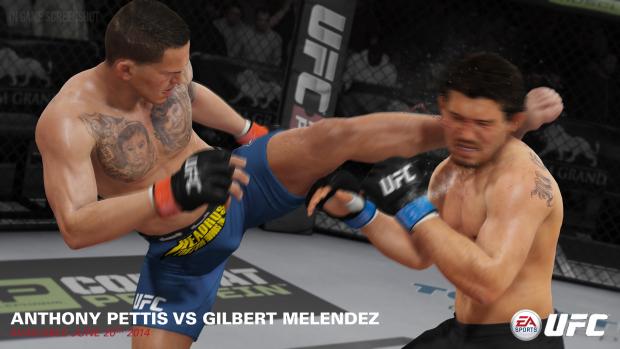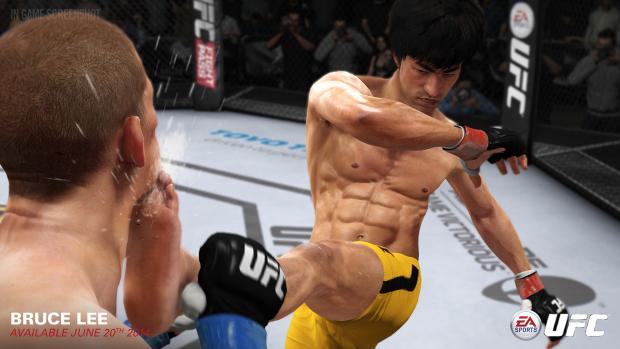Mixed Martial Arts is one of the most popular sports in the world right now. Its yearly pay per view sales in America have surpassed those of Boxing, and it attracts a much more diverse fan-base, taken from all ages and genders. So when THQ were suffering financial woes, it came as no surprise that sporting powerhouse EA Sports was quick to snap up the rights to the Ultimate Fighting Championship series. EA Sports have been producing top-class Boxing titles for years, and had already produced EA Sports MMA – an impressive, albeit not fully licensed, first stab at the MMA genre.
UFC was seen as such an important title for EA Sports that the Fight Night development team were taken off that famous series to be set to work on this new series for the company. By putting a team who are so experienced with combat sports to work on UFC, we can see that obviously this is a game that the studio wanted to get right first time. And whilst the game has some impressive features and may win a points decision, EA Sports UFC is sadly not the knockout title that fans may have been hoping for.

The game is split into three main distinctions: the stand-up game (punching and kicking); the ground game (throws, holds and transitions), and submissions. The Stand-up game is understandably a strong point of this title. Unfortunately, the wrestling and submission gameplay just doesn’t match up.
Due to MMA being an unpredictable sport, you can have matches last for five seconds, five minutes, or five rounds with a judges decision deciding the outcome. As such, blocking and defence is just as important as offensive moves in your stand-up arsenal. Thankfully the blocking and parry systems are implemented well and it’s fairly easy for players to pick up. EA Sports UFC takes you through a ten-minute tutorial before you do anything else, and it does a good job of explaining most of the ins and outs of controlling your fighter.
Of course, fights sometimes degenerate into slugfests, especially in multiplayer, but when playing on higher difficulties the AI gets pretty cagey and tactical, requiring you to fight a much more clever fight. This will involve only throwing punches or kicks when your stamina meter is full (as the power of your strikes suffers more the lower your stamina gets), looking to hit quick counter strikes after you have successfully countered your opponents’ ones, and also knowing when is a good time just to keep out of your opponents’ way.

One good way to buy yourself some time to recover if you are worried you are taking too much damage, or when you have been rocked by a big hit (being rocked will mean you can’t block or parry hits as successfully as usual), is to try to clinch or go for a takedown. Sadly, the system for transitioning between different situations in clinches or when on the ground just doesn’t seem to work as fluidly as it should. The controls are more or less the same as found elsewhere, but here you just don’t seem to have the same control in wrestling situations.
There are two extremes in EA Sports UFC: either your fighter will escape from and counter all holds with ease, meaning the fight hardly stays on the floor at all, or your opponent sticks to you like glue and all attempts at transitions and blocks just seem to do nothing. This doesn’t seem to be determined by your stamina or body condition in a fight, it just seems random. If the system worked that the longer the fight went on, the weaker your fighter became; the harder to make transitions (and vice versa) then that would make perfect sense. Strangely though, these factors don’t seem to effect the ground game like they should, and it is hard to predict whether your fighter will put up a fight or not.

Submission systems have changed somewhat, and now appear as a tug of war. An octagon logo appears on-screen and the defending player has to try to push their right stick up, down, left or right, until their icon can touch the edge of the octagon. At the same time, the attacking fighter tries to match up the same direction presses, to prevent the escape. This gives both players immediate visual feedback as to how a submission is progressing, and definitely puts the emphasis on having to work to submit someone – whereas submissions could often be won a bit too cheaply in past titles.
The only bad thing is that whereas you needed a decent amount of stamina to implement a submission in other games, with each attempt draining a bit of your stamina, EA Sports UFC seems to let you try submission attempt after submission attempt, without stopping you. This means that if an opponent gets you on the mat, they can apply six or seven submissions one after the other, which makes the whole fight seem wholly unrealistic. You do need a decent amount of stamina if you want to complete a submission, but it seems to immediately refill after a failed attempt, allowing you to try again straight away.
Aside from gameplay, the title consists of all of the modes that you would expect, like a career mode and create-a-fighter system, where you can create yourself and work your way up from The Ultimate Fighter reality TV series and gain a UFC contract, before climbing the rankings and targeting a title shot. One nice addition is a cumulative damage meter for careers, so if you defend poorly and allow yourself to take a lot of hits, your career can be cut short through injury – encouraging fighters to fight smart. This adds some realism to the career, where you can’t fight forever and puts a time-scale on how long you have to work your way into title contention.

Then there is challenge mode. A list of around one hundred short training routines. These also appear throughout the career mode between fights, to help you level up your fighter’s abilities. Sadly, They are all pretty boring – meaning you are unlikely to want to complete ten of them, let alone one hundred. They are obviously intended to help teach you different manoeuvres in the game, but aren’t structured in an interesting enough way.
Multiplayer fighting is probably the most fun you will have here, whether that be online (which includes online leagues and tournaments) or local match-ups. Fighting another human is always a more exciting and unpredictable affair. Probably due to the strength of the striking systems, they do, more often than not, remain stand-up contests, but this does lead to a lot of crazy knockouts, and back and forth fights where both contenders are knocked down multiple times. Play against a more experienced fighter, and bouts become a lot more like a game of chess, but there is still an extra level of unpredictability that is missing from fights against AI, which makes multiplayer in UFC so much fun.
Visually, it all looks great on the surface, with extremely detailed character models who look just like their real-life counterparts, deforming realistically when injured. Due to the overall lack of animations, there is too little variety in the moves we see. Whether you play as a lightweight or a heavyweight, they both move very similarly and there isn’t enough visual distinction between fighters and their styles. The audio is also a little hit and miss, with commentary sometimes getting a bit stuck and crowd sounds sometimes inexplicably going silent – creating a very strange fight atmosphere indeed.
VERDICT: EA Sports UFC wouldn’t be bad for a first shot at the MMA genre. But EA had already dipped their toe into the genre, and seem to have done little to move on from there. The striking is very satisfying, and the new submission system is interesting and creates a more level playing field than in the past, but the game is let down by poor wrestling and transition mechanics. There’s enough here to show that a second UFC title from EA is likely to be a great game, but this one just needed a bit more time in the gym.

GOOD. A game that scores 7/10 is worthy of note, but unworthy of fanfare. It does many things well, but only a few of them incredibly well and, despite a handful of good qualities, fresh ideas and solid mechanics, it fails to overwhelm.
Review code provided by publisher. PS4 version also tested.






